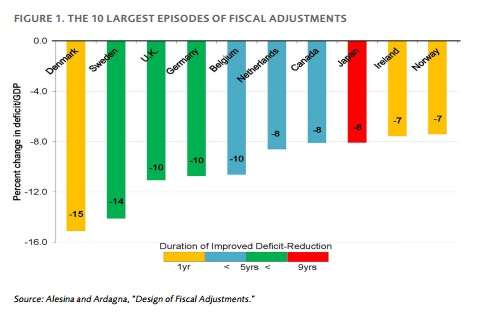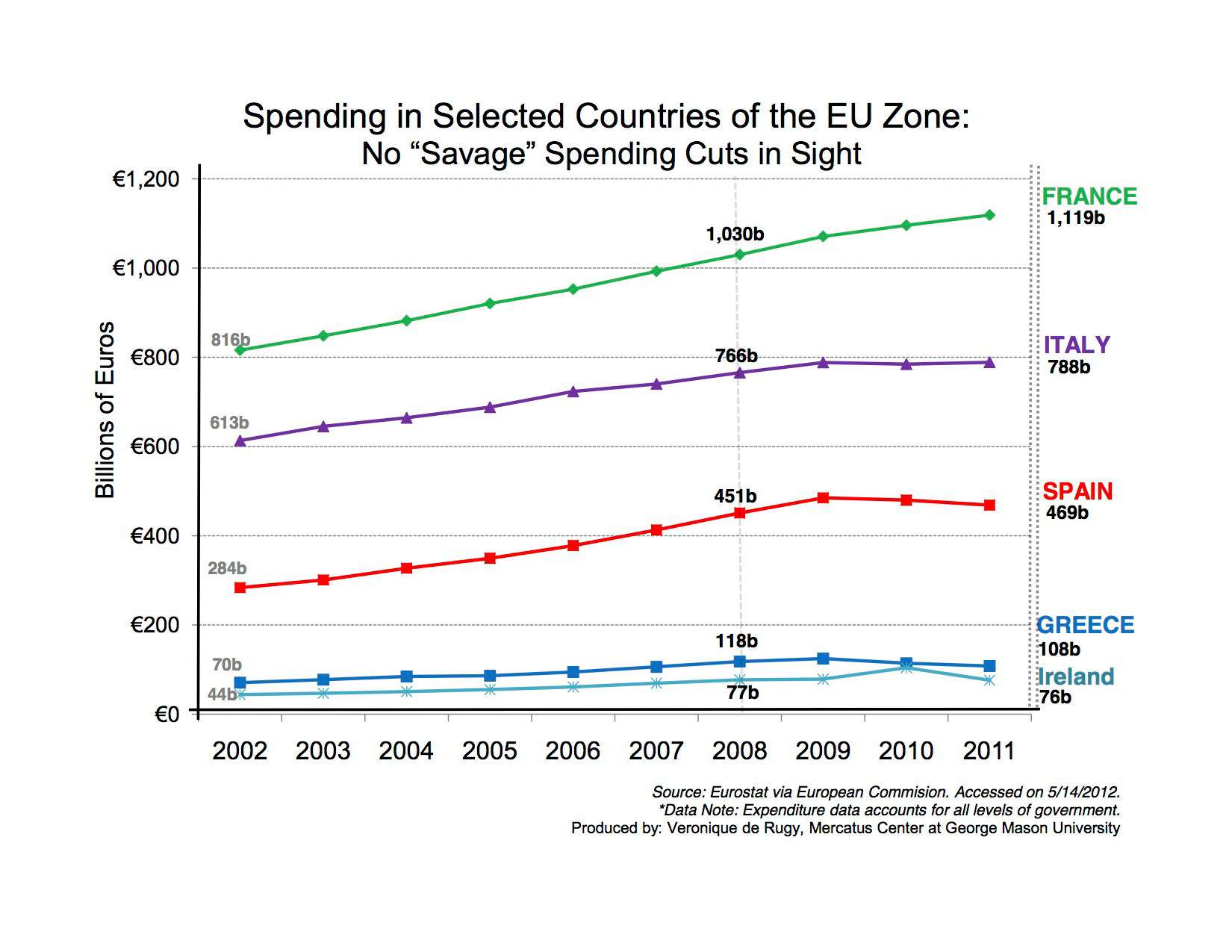Just Like Cheese, Wine, & Bread, There's Good Austerity and Bad Austerity

Austerity - attempts by governments to reduce the debt-to-GDP ratio - is very much in the international news these days. Most countries have been spending money they don't have and are getting worried that excessive amounts of debt are impeding economic recovery.
Broadly speaking, every politician is in favor of austerity, including Barack Obama, John Boehner, and Harry Reid, who all agree we need to stabilize and reduce our debt-to-GDP ratio. Yet we read almost daily that Britain, or Ireland, or Greece, or wherever has "tried" austerity and "it" has failed. Most recently, the ass-kicking that the party of Italian politician Mario Monti took at the polls has been read as yet another indictment of "failed austerity." The standard line is that Monti put in place "savage" cuts that did nothing to revive the economy but made every aspect of Italian life worse by cutting the social safety net and draining the economy of demand.
Denunciations of austerity might scant the many pragmatic (not ideological) reasons to reduce the debt-to-GDP ratio. Interest in austerity isn't about some weird, left-over Protestant admonition against taking on debt. In countries with smaller economies, tightening the debt-to-GDP ratio typically reduces borrowing costs since it's seen as a sign that a government is not spending wildly and risking all sorts of meltdowns associated with that sort of behavior. In general, smaller debt-to-GDP ratios mean that there's some sort of political harmony between taxes and spending, which relieves fears of major tax hikes and other unpredictable political events in the future (parties paid for by borrowed money have to end sometime). From a strictly Keynesian perspective, a tight debt-to-GDP ratio means that short-term, temporary stimulus spending is not only easier to finance but more likely to give the sort of economic boost the theory describes. The best argument for austerity, though, has to do with national debt's long-term effect on growth rates. Economists Carmen Reinhart, Vincent Reinhart, and Kenneth Rogoff argue that sustained debt-to-GDP ratios greater than 90 percent ("debt overhangs") are likely to massively reduce future growth for decades. Indeed, in the episodes they surveyed, debt overhang clipped more than a percentage point off of growth for 20-plus years, meaning that overal growth could be reduced by almost 25 percent. That can be the difference between first-world and second-world living standards. Debt overhang effects the U.S. economy, the world's largest, even if we don't have to worry as much as Greece about lenders calling their notes.
There are different ways to enact austerity and which way you choose matters immensely.
You can raise taxes, cut spending, or some combination of the two. As economists Alberto Alesina and Veronique de Rugy (the Reason columnist, Mercatus Center analyst, and my frequent co-author) argue in a piece at Forbes and in a major new study released by Mercatus, the best way is to sharply reduce spending while either holding taxes constant or cutting them and enacting other pro-market reforms. At Forbes, they write:
"Austerity" implemented through tax hikes is harmful, but austerity based on appropriate spending cuts is the best way to reduce a country's public debt burden. Implementing pro-growth reforms as part of the fiscal adjustment process can minimize any economic cost that budget cuts may have. This is especially important in the case of highly regulated economies where the government spends about half of its GDP, as is the case with Italy.

Observers such as Paul Krugman are mistaken when they point to European austerity measures and say such outcomes prove that cutting spending doesn't work. The fact is that spending generally hasn't been cut. Monti might have been elected on promises of cutting spending but, write Alesina and de Rugy at Forbes, "the Italian government implemented the wrong kind of austerity":
First, it raised the tax burden on its workers. Tax revenues consumed an additional 2.5 percent of GDP, bringing the total up to 45 percent. While some of those increases were already in place when Monti took office in November 2011, he chose to continue with the tax hikes. Considering the large amount of tax evasion in Italy (estimated conservatively at around 15 per cent of GDP) those who actually pay their taxes are truly squeezed.
Second, with the exception of good pension reform, the effect of which will not be felt on the budget for a few years, the actual spending cuts have been minuscule. Traditionally, the "cuts" in the budget presented in parliament are mostly a reduction in transfers from the central government to local governments. But the latter often reacts by raising local taxes, effectively wiping out the good from "spending cuts." The only real cuts approved by the Monti government in 2012 were tiny; somewhere between 1 billion and 8 billion euros, representing at best, less than 1 percent of the $790 billion budget. These are a tiny fraction of Italy's GDP, plus it remains uncertain whether or not they'll be fully implemented to begin with.
So the next time someone squawks that "austerity has failed in Europe!" ask them two questions: How much was spending actually cut and how much were taxes actually raised? I've found that most people who pooh-pooh the very idea of austerity or the spending-cut version generally have no grasp of whether spending has been cut or taxes raised. Last May, for instance, I appeared on MSNBC's Melissa Harris-Perry show with the Washington Post's Ezra Klein and The Nation's Katrina vanden Heuvel, neither of whom was willing or able to point to actual spending cuts by the British government at that point in time. Yet that didn't stop them from pronouncing on the issue.
Part of the confusion is that politicians - surprise! - often due the exact opposite of what they say they will do. In the Mercatus paper, Alesina and de Rugy note that the British government enacted the reverse of its announced reforms:
In a paper on the United Kingdom's fiscal adjustment, economist Anthony Evans noted that the original austerity plan announced by Chancellor George Osborne would cut £3 in government spending for every £1 in new tax revenue over the full austerity cycle. But what was announced has not happened yet. A look at the first two years of fiscal adjustment, for instance, reveals that roughly £40 billion was shaved from the deficit during the 2010–2011 budget cycle by raising £3 of new tax revenue for every £1 in cuts—exactly the reverse of what was promised.
Raising taxes and making minor spending cuts are actions that should sound familiar to Americans. If that doesn't work either to reduce the debt-to-GDP ratio or to revive the economy, what might?
Alesina and de Rugy look at successful attempts to reduce the ratio (and note that about 80 percent of attempts fail) and find common traits. When it comes to reducing debt-to-GDP, the most important thing is that action happens on the spending side rather than the tax side. That is, spending cuts are made, along with liberalization of labor and trade laws, and the like. They stress that in advanced-economy countries where the government is already spending a relatively large share of GDP, it is relatively easy to trim outlays without gutting social safety nets (they note in passing too that politicians who cut spending are often rewarded with re-election). The hugely successful example of Canada's spending-cut-based austerity program from the 1990s - the country cut spending and taxes while reforming its pension system - is worth looking at in some detail.

Alesina and de Rugy stress that reducing the debt-to-GDP ratio by cutting spending doesn't necessarily mean that the economy will bounce back. But they also note
while not all fiscal adjustments lead to economic expansion, spending based adjustments are less recessionary than those achieved through tax increases. Moreover, when successful spending-based adjustments were not expansionary, they were associated with mild and short-lived recessions, while tax increases were unsuccessful at reducing the debt and associated with large recessions.
One of the great fears of cutting government spending is that it by definition reduces short-term GDP (simply because most government spending, unlike private-sector spending, is automatically counted as GDP). That fear - remember the uproar over the last quarter's shrinkage attributed to a reduction in defense spending? - justifies never cutting spending, which only perpetuates sluggish economic growth, which in turn justifies more borrowing and spending.
The paper by Alesina and de Rugy should be required reading for all economic analysts and policymakers. It offers a perspective that is rooted in real-world experience that has, not surprisingly, been largely ignored by the people who should be most attentive.


Show Comments (62)